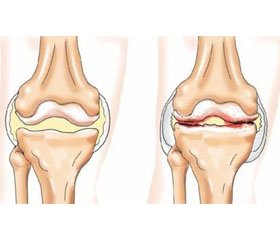Журнал «Боль. Суставы. Позвоночник» 1 (21) 2016
Вернуться к номеру
Osteoathritis of large joints in the patients with diabetes mellitus
Авторы: Geiko I., Taktashov G., Syniachenko O., Iermolaeva M., Syniachenko T., Verzilov S. - Donetsk National Medical University named after M. Gorky, Liman, Ukraine
Рубрики: Ревматология, Травматология и ортопедия
Разделы: Медицинские форумы
Версия для печати
The article was published on p. 70-71
Introduction. Osteoarthritis has a great medical, social and economic influence on the society, and the most pressing problem is considered to be knee and hip joint diseases, as gonarthrosis (GA) and coxarthrosis (CA) are the most disabling localizations of the pathological process. Diabetes mellitus (DM) is one of the independent risk factors for the development of osteoarthritis.
The objectives of this research were the comparative evaluation of clinical, radiological and sonographic signs of GA and CA in the patients with different types of DN and in the patients without it, the study of the links of the bone-destructive characteristics with the disturbances of carbohydrate metabolism including physical, chemical integral indices, the determination of the effect of DM on the rates of the progression of the changes in the knee and hip joints.
Material and methods. There were 153 patients with osteoarthritis who were divided into two groups. The 1st (main) group consisted of 47 people (16 men and 31 women aged 25 to 72 years) with DM, and the 2nd (control) group included 106 patients without DM (83 men and 23 women aged 32 to 73 years). The average age in the 1st and the 2nd groups was 54 years old and 49 years old (the differences were authentic), respectively. Type 1 DM (DM1) and type 2 DM (DM2) were diagnosed in 24 % and 76 % of the cases, respectively. The indices of the severity and progression of GA and CA have been calculated. The patients were underwent the X-ray and ultrasound examination of the knee and hip joints, as well as dual-energy X-ray osteodensitometry of the proximal femur. The concentrations of glucose, glycosylated hemoglobin and insulin have been studied in the blood, the surface tension of blood serum, its viscoelasticity module, the slope and the phase slope of tensiograms with the calculation of the indices of insulin resistance, glycose ratio of interfacial activity, adsorptive and glycose integral ratio have been determined.
Results. In the patients with OA and with DM the hip joints in 3.7 times are likely to be involved in the process and in 1.2 times more — the knee joints. Diabetes affects the severity of GA and CA. Polyarthrosis has been revealed in 98 % of the patients with DM and in 63 % among the rest ones. The cases of tendovaginitis have been detected in 55 % of the cases of diabetes and the cases of enthesopathy have been revealed in 21 %, whereas these cases have been diagnosed only in 2 % and 3 % in the control group. The incidence of reactive synovitis in both groups showed no significant difference (45 and 54 %). Heberden's nodules occurred in 10 % of the cases, Bouchard’s nodules — in 4 %, the signs of spondylarthrosis and osteochondrosis of the cervical spine were detected in 37 % of the cases, thoracic osteochondrosis — in 41 %, lumbar osteochondrosis — in 63 %. The analysis of variances shows the dependence of the development of osteocytosis, subchondral sclerosis, epiphyseal osteoporosis, intraarticular calcifications, ligamentosis and cartilage flaps in GA from DM, but it doesn’t demonstrate the dependence of the amount of narrowing of articular fussure, the formation of Baker’s cysts, Hoff and Pellagri-Shtaidi bodies from DM. In general, shown statistically significant components of GA were detected in 30, 55, 64, 38, 18, 16, 13 % of the number of the surveyed, respectively. DM in the patients with OA determines the number of affected joints in the form of polyarthrosis, not only starting, but also morning stiffness, the increase of the frequency of some roentgenosonographic signs of the articular syndrome, the severity of the involvement of the spine, knee and hip joints in the process that depend on the rates of insulinemia and glycosylated hemoglobin in the blood. The development of GA and CA is often observed in the patients with DM of type 2, which is more aggressive factor as for the hip joint disease, while DM of type 1 in the patients with GA causes mainly the cases of tendosynovitis and enthesopathy. In such cases the intensity of synovitis is associated with diabetic macro- and microangiopathy. The presence of DM in the patients with GA affects the formation of osteocystosis, subchondral sclerosis, osteoporosis, intraarticular calcifications and cartilage flaps, ligamentosis.
Conclusion. DM affects the course of the GA and CA, and the detection of the disturbances of carbohydrate metabolism in such joint pathology can have a practical significance as a risk factor of some structural changes of articular and periarticular tissues.

